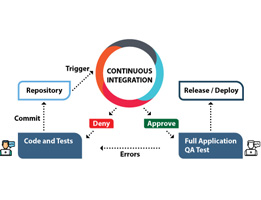Continuous integration (CI) is a method of integrating changes needed in one single project which is developed, then tested accordingly, this method helps developers to deliver a software in a more efficient and a predictable manner.
To understand the importance of continuous integration first we understand how the process is going before continuous integration is coming in market.
Before continuous integration there is a process of traditional integration in which team of four to five developers working on different module of a one single project and execute unit test of modules, one by one. After successful testing of each module they integrate all modules and perform integration testing.
These processes of development is become very complex and developers need to manually coordinate with each other whenever for any new change in any module they need to change all related module of a software.
CI provides complete solution for these problems. There is no long integration processes, every time team know where they are, what work they are doing, how the process is going, also team is aware about project status from frequently doing automated build and testing of a code.
Through CI we don’t get rid of bugs, but CI make easier to find bugs and remove it. If developers found a bug and notice it quickly it’s far easier to get rid of. So when ever any module has small bit of change developers don’t have look so far because that small bit of change just they work with and it’s easy to find a bug.
One of the best examples of CI is DevOps, it include techniques for repetitions in software development life cycle (SDLC) such as automated building of a software, testing and deployment, this process is known as a continuous integration and continuous deployment.
Benefit of integrating module is we can easily detect errors & fix it by earliest because each integration is check by an automation build with test to find integration errors as rapidly.
Benefits of CI:
- Reduce integration risk
- Higher code quality
- Increase visibility & transparency
- Detect issue early
- Self-testing build
- Keep build fast
- Reduce development/deployment time
- Rise Test Reliability
CI came out as a foremost process because developers frequently work as separate module and end of the day, they need to merge their changes with all other modules. Waiting for a weeks or months to integrate each module creates more clash and hard to fix that bugs and deployment of software. CI demands each module code to be integrating as a shared version continuously, to avoid issues.




